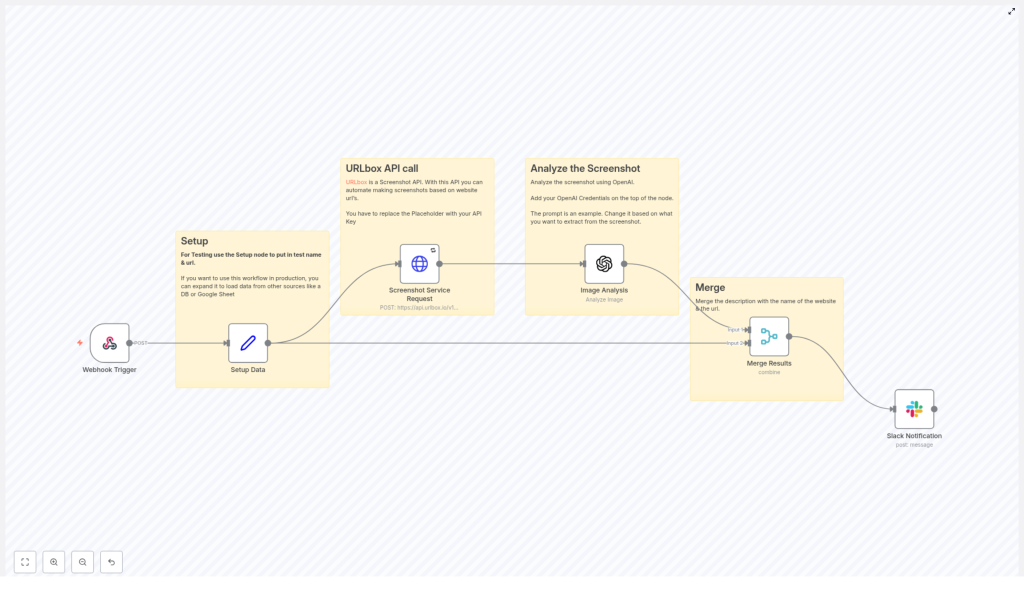Analyze Screenshots with AI using n8n, URLbox and OpenAI
Automating the capture and analysis of website screenshots lets teams monitor UI changes, extract visual content, and surface insights to Slack or other systems. In this guide you’ll learn how to build a reliable workflow in n8n that captures screenshots via URLbox, analyzes them with OpenAI image tools, merges results with metadata, and sends a notification to Slack.
Why automate screenshot analysis?
Manual screenshot capture and inspection is slow, error-prone, and doesn’t scale. Automating the process unlocks use cases like visual regression monitoring, content extraction, competitor tracking, and automated reporting. Using n8n, you can orchestrate third-party services with no-code / low-code nodes and add AI image analysis to derive meaning from pixels.
Overview of the workflow
The example workflow follows a simple sequence:
- Webhook trigger – receive a URL and website name
- Setup node – populate the request payload
- URLbox screenshot service – capture a full-page screenshot
- OpenAI image analysis – describe and extract content from the screenshot
- Merge node – combine description with website metadata
- Slack notification – post the analysis to a channel
Key components and services
n8n
n8n is the automation platform used to orchestrate nodes. It handles webhook triggers, HTTP requests, merging data, and connecting to Slack.
URLbox
URLbox provides a Screenshot API to render web pages as images. It supports options like full page capture, viewport size, and mobile emulation. Replace the placeholder authorization header with your URLbox API key.
OpenAI image analysis
The Image Analysis (or Vision) model analyzes the screenshot to produce descriptions, detect text (OCR), and extract structured insights. Fine-tune the prompt to extract the fields you need (e.g., hero headline text, CTA presence, brand logos).
Step-by-step setup
1. Create a webhook trigger
Start with an n8n Webhook node configured for POST requests (example path: /screenshot-webhook). This allows external services or test tools to submit a JSON payload that includes a URL and website name.
{
"website_name": "n8n",
"url": "https://n8n.io/"
}
2. Populate the payload
Use the Set node to prepare any defaults and store values such as website_name and url. This makes it easy to wire static values for testing or map values from the webhook payload.
3. Capture a screenshot with URLbox
Add an HTTP Request node that posts to the URLbox render endpoint (for example: https://api.urlbox.io/v1/render/sync). Include the URL in the body parameters and set full_page=true to capture the entire page. Set the Authorization header to your URLbox API key.
Important options:
- full_page: true (capture entire page)
- viewport: set width/height if desired
- format: jpg or png
4. Analyze the screenshot with OpenAI
Pass the image URL or binary data to an OpenAI image analysis node. In n8n you can use the Image Analysis node (or the LangChain/OpenAI integration) and send a prompt like:
“Your input is a screenshot of a website. Describe the content in one sentence and extract the main headline and any visible CTA text.”
Tips for robust prompts:
- Ask for structured JSON output to make downstream parsing easy (e.g., headline, cta_text, detected_logos).
- When you expect text, include a request for OCR output.
- Limit verbosity and prefer concise fields for automated processing.
5. Merge metadata and analysis
Use the Merge node to combine the website metadata (name, url) from the Set node with the image analysis output. Merge by position or key depending on how your nodes are connected. The result should be a single JSON object suitable for notifications.
6. Send a Slack notification
Finally, post a message to Slack summarizing the result. A compact message could look like:
Website: n8n
URL: https://n8n.io/
Analysis: Hero headline: "Automate your workflows" — CTA: "Get started"
Include the screenshot link or attach the image if your Slack integration supports it.
Security and best practices
- Keep API keys secret: Use n8n credentials to store your URLbox and OpenAI keys rather than embedding them in nodes.
- Rate limits: Be mindful of URLbox and OpenAI rate limits; add retry/backoff logic in n8n.
- Cost control: Capture only the pages you need and avoid frequent full-page renders unless required.
- Output validation: Validate the AI response before posting to Slack to avoid unexpected content.
Error handling and retries
Configure the HTTP Request node to retry on failures. Add branching logic to catch OpenAI errors or empty responses — for example, send an alert to an admin channel if analysis fails or the image is missing.
Advanced ideas and extensions
- Batch processing: Loop over a list of URLs from a Google Sheet or database and run the workflow on each entry.
- Visual regression: Compare current screenshots to previous captures using an image diff tool and alert only when differences exceed a threshold.
- Structured extraction: Ask the AI for JSON with specific fields (headline, promo, price, form fields) and feed results to a database.
- Multi-model pipeline: Use OCR first for text extraction, then run a classification model to detect logos, colors, or layout type.
Sample prompt for reliable extraction
Use a prompt that asks for a strict JSON response. Example:
"Analyze this website screenshot. Return JSON with keys: 'description', 'headline', 'cta_text', 'detected_text'. If a key is not present, return null."Wrap-up and call-to-action
Automating screenshot capture and AI-driven analysis with n8n, URLbox, and OpenAI unlocks fast, scalable monitoring and content extraction for product, marketing, and QA teams. Start with a simple webhook-driven workflow, iterate on your prompts, and add error handling and batching as you scale.
Ready to build this workflow? Try the template included in this post or reach out to get a custom automation tailored to your use case. If you’d like, I can provide a ready-to-import n8n workflow JSON and example prompts for headline extraction — just ask!
Next step: Copy the example template, add your API keys in n8n credentials, and run a test using your website URL.

